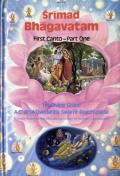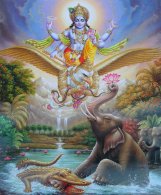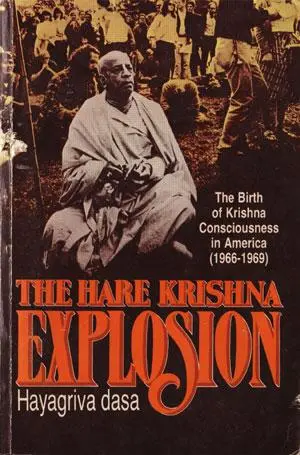30 Nov 2014
by The Hare Krishna Movement
in Back to Godhead, Brahmananda das, The Hare Krishna Movement
Tags: A.C. Bhaktivedanta Swami, Back to Godhead Magazine, brahmacari, Brahmananda das, Brahmananda Swami, BTG, BTG Vol.10 No. 12, How the Hare Krsna Movement came to Africa, krsna consciousness, prabhupada, preaching in Africa, The Hare Krishna Movement

How the Hare Krsna Movement Came to Africa
by His Holiness Brahmananda Swami
Excerpted from; Back to Godhead Magazine 1975 Vol. 10, No. 12
The story of how the Hare Krsna movement came to Africa starts in 1971 in the United States. I was in Tallahassee, Florida, teaching an experimental course in Krsna consciousness at the state university, when I received a letter from my spiritual master, His Divine Grace A.C. Bhaktivedanta Swami Prabhupada, instructing me to go immediately to West Pakistan for preaching work. I had very little money, and I knew the trip to Pakistan would be long and arduous. However, a disciple takes his spiritual master’s order as his very life and soul, and I was determined that nothing would stop me.
More
29 Nov 2014
by The Hare Krishna Movement
in A.C. Bhaktivedanta Swami Prabhupada, Books by Srila Prabhupada, Conversation with Srila Prabhupada, George Harrison, Photos by Gurudas, Sriman George Harrison
Tags: George Harrison, Krsna Book, Mukunda, philosophy, photo by Gurudas, Srila Prabhupada, Srila Prabhupada conversations with George Harrison, Srila Prabhupada's books

click on image to enlarge
Conversations with George Harrison
London, England – July 26, 1976
Srila Prabhupada: “Are you reading sometimes my books? Which one?”
George Harrison: “Mainly Krsna.”
Srila Prabhupada: “That is the main book.” [laughs)
George Harrison: “Mukunda gave me the new books, but there’s so much to read.”
Srila Prabhupada: “Philosophy.”
George Harrison: “I don’t know how anybody could have written it, it’s is difficult to read all that amount”
Srila Prabhupada: “Sometimes, they are surprised how one man can write so many books, but it is Krsna’ s grace. Otherwise, not possible. Human being, it is not possible.”
More
29 Nov 2014
by The Hare Krishna Movement
in A.C. Bhaktivedanta Swami Prabhupada, Diksha, Disciplic succession, Guru & Disciple, guru-tattva, Hansadutta das, Letters by Srila Prabhupada, Ritvik Initiation, Spiritual Master
Tags: A.C. Bhaktivedanta Swami, Ama das, Atmavidya das, Durgama das, Gobhata das, hamsadutta prabhu, Hrimati dasi, Jnanavigraha das, Kamaksi dasi, letter to hamsadutta, Nikhilananda das, Premchand das, Ram Mohan das, Ramgati das, Revantinandana Swami, Santimati dasi, Srila Prabhupada, Tirthada das, Uktal das, Vaidyanath das

I read this letter today, by Srila Prabhupada to Hamsadutta Prabhu, written in 1973, putting in practice, the process of ritvik initiation (although we did not have a name for it then, it was simply how it was done); “…Please accept my blessings. I am in due receipt of your letter dated April 7, 1973 and am pleased to accept the following boys and girls as my initiated disciples.
I am also enclosing Gayatri Mantras for the 14 disciples and 10 sacred threads duly chanted upon by me for the men disciples. You show them how to count on the fingers, and let them hear the mantra chanted by me on the tape through the right ear.”
What I find interesting is how devotees today will decry and belittle the Ritvik Process of initiation, but this was how the initiations were performed in the early days of our movement. The majority of disciples, initiated by Srila Prabhupada when he was personally present, received initiation exactly as it was described in above letter. We almost all recieved Ritvik initiation from Srila Prabhupada. I know I did.
Anyway, food for thought.
Letter More
28 Nov 2014
by The Hare Krishna Movement
in Japa, Meditation
Tags: chanting Hare Krishna, chanting japa, Hare Hare, Hare Krishna, Hare Rama, japa, kirtana, Krishna Krishna, mantra, mantra meditation, meditation, Rama Rama

Japa
Chanting a mantra or hymn softly and slowly is called japa, and chanting the same mantra loudly is called kīrtana. For example, uttering the mahā-mantra (Hare Kṛṣṇa, Hare Kṛṣṇa, Kṛṣṇa Kṛṣṇa, Hare Hare/ Hare Rāma, Hare Rāma, Rāma Rāma, Hare Hare) very softly, only for one’s own hearing, is called japa. Chanting the same mantra loudly for being heard by all others is called kīrtana. The mahā-mantra can be used for japa and kīrtana also. When japa is practiced it is for the personal benefit of the chanter, but when kīrtana is performed it is for the benefit of all others who may hear.
In the Padma Purāṇa there is a statement: “For any person who is chanting the holy name either softly or loudly, the paths to liberation and even heavenly happiness are at once open.” (from Nectar of Devotion Chapter 9)
click on link; Srila Prabhupada Chanting
More
27 Nov 2014
by The Hare Krishna Movement
in Guru das, Photos by Gurudas, Roger Siegel, Srila Prabhupada, Yamuna devi
Tags: Gurudas, kirtan by Yamuna devi, morning walks with Srila Prabhupada, photos by Gurudas, Roger Siegel, srila prabhuopada in san franscio, Srila Prabhupada, walks with prabhupada, Yamuna devi
Photos by Gurudas
Walks with Srila Prabhupada in San Francisco

Music by Yamuna
Gallery More
27 Nov 2014
by The Hare Krishna Movement
in Vegetarian Cooking, Vegetarian Recipies
Tags: egg-less cooking, eggless sweet potato pie, homemade pie crust, sweet potato pie, sweet potato puree, thanksgiving, thanksgiving recipe, vegetarian recipies, vegetarian sweet potato pie

Today in the West people are celebrating “Thanksgiving”. So we are posting a traditional Thanksgiving recipe; Sweet Potato Pie (without the eggs). I have been making egg-less pies for the last 39 years, and have tried many different variations. I use 2 tablespoons of sour cream instead of 2 eggs, and one year I used Philadelphia cream cheese instead of evaporated milk, all with good success.
If you want to do everything yourself, there is the do it yourself recipe for a “homemade” pie crust, sweet potato puree, spicing, and sweetened whipped cream.
More
26 Nov 2014
by The Hare Krishna Movement
in A.C. Bhaktivedanta Swami Prabhupada, Bhagavad-gita, Lectures
Tags: A.C. Bhaktiveanta Swami Prabhupada, asuras, Draupada, draupadi's vastra-harana, Durga, Lecture by Srila Prabhupada, Lecture on Bhagavad gita, papam, pious acitivity, punyam, sinful activities

I have always liked this story of the dis-robing of Draupadi, and how she was saved by Krsna supplying endless heaps of sari. The following lecture by Srila Prabhupada is a very nice description of the contest between good and evil, or pious or impious activities.
Prabhupāda: So pāpam eva. Pāpam means sinful activities, and puṇyam is pious. So people should consider in every activity, whether it is pāpam or puṇyam, whether it is virtuous or sinful activities. But the asuras, they do not know. Pravṛttiṁ ca nivṛttiṁ ca na vidur asurā janāḥ [Bg. 16.7]. Those who are asuras, they do not care what is sinful or what is right. “I like it; I must do it.” This is asura. There is no reference to the authorities, whether the action which I am going to do, whether it is pious or impious…
…”Now she is our property. We can do whatever we like with. Arjuna has lost his wife.” So he advised that “Make her naked in this assembly.” To become naked in the, so many people, that is a great insult for woman. So actually, they tried to insult. Not tried, it was fact. But Kṛṣṇa saved. You know, Draupadi’s vastra-haraṇa. She was tried to become naked, but these people could not make her naked. The sārī was supplied by Kṛṣṇa, one after another, one after another, heaps of sārī. Then they become fed up, gave up that business, that “She cannot be made naked.” (from Bhagavad-gita 1.36 Lecture)
Full Lecture More
25 Nov 2014
by The Hare Krishna Movement
in Uncategorized
Tags: Bg 2.51, Bhagavad-gita As It Is, buddhi-yoga, By His Divine Grace A. C. Bhaktivedanta Swami Prabhupada, material world, mukti, param padam, SB 10.2.32, the place where there are no material miseries, vaisnava vocabulary, water contained in a calf's hoofprint

This morning, I stumbled upon the words; param padam, padam padam, when I was reading from the purport to Bhagavad-gita 2.51:
The liberated living entities seek that place where there are no material miseries. The Bhāgavatam says:
samāśritā ye padapallava-plavaṁ
mahat-padaṁ puṇya-yaśo murāreḥ
bhāvambudhir vatsa-padaṁ paraṁ padaṁ
paraṁ padaṁ yad vipadāṁ na teṣām
(Bhāg. 10.14.58)
“For one who has accepted the boat of the lotus feet of the Lord, who is the shelter of the cosmic manifestation and is famous as Mukunda or the giver of mukti, the ocean of the material world is like the water contained in a calf’s hoofprint. Param padam, or the place where there are no material miseries, or Vaikuṇṭha, is his goal, not the place where there is danger in every step of life.” (from purport to Bg 2.51)
I wanted to know the exact meaning of the words param padam, so I did a search and have included it here as a post and as another entry into our ‘Vaisnava Vocabulary’ category.
More
24 Nov 2014
by The Hare Krishna Movement
in Vegetarian Cooking, Vegetarian Recipies
Tags: cooking paratha's, Indian cooking, paratha, unleavened flat breads, vegetarian recipies

For years I have enjoyed eating Paratha’s (unleavened flat breads) at festivals, weddings, and other devotee gatherings, but have never actually learned how to cook them. So this weekend I took out the Indian Cookbooks and found a nice recipe and fried some up, and offered them to the Lord. They were easy to prepare, and very delicious.
They can also be stuffed and we will explore this option in a later post.
The following recipe I found on the Internet at tarladala.com, and the images are not mine but also gathered online. Also in this post is addition information on the history of Paratha’s.
Ingredients
1 cup whole wheat flour (gehun ka atta)
salt to taste
1 tsp oil or ghee
whole wheat flour for rolling
melted ghee for brushing and cooking
Method
Combine all the ingredients in a deep bowl and knead into a semi-soft dough using enough water.
Divide the dough into 6 equal portions.
Roll each portion into a 125 mm. (5″) diameter circle, using a little whole wheat flour for rolling, brush with melted ghee, fold into half to form a semi- circle.
Brush the semi-circle with melted ghee and fold again to form a triangle.
Roll out into a 125 mm. (5″) length triangular paratha using a little whole wheat flour for rolling.
Heat a non-stick tava (griddle) and cook each paratha on both the sides, using a little ghee, till brown spots appear on both the sides.
Repeat steps 3 to 6 to make 5 more parathas.
Serve hot with fresh curds.
Additional information More
23 Nov 2014
by The Hare Krishna Movement
in A.C. Bhaktivedanta Swami Prabhupada, Nine Processes of Devotional Service, Srimad Bhagavatam, Teachings of Pralada Maharaja, Yoga
Tags: A. C. Bhakthvedanta Swami Prabhupada, Akura, Arjuna, Bali Maharaja, goddess of fortune, Hanuman, Krishna, Lamxi, Maharaja Pariksit, Maharaja Prthu, Prahlada Maharaja, Rama, sarvanam kirtanam visnoh, SB7.5.23-24, Sri Ramacandra, Sri Vamanadeva, Sukadeva Goswami, the science of God
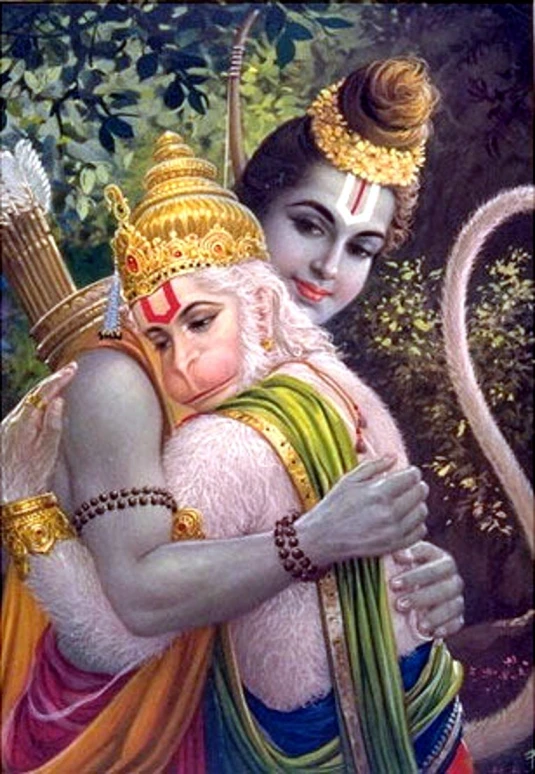
The Nine Processes of Devotional Service
The Nine Processes of Devotional Service are described by Prahlada Maharaja in the 7th Canto of the Srimad Bhagavatam, chapter 5, text 24-25. The great personalities who attained perfection by practice of the nine processes are listed below, followed by the complete text and purport, describing in full these nine processes. If I am not mistaken, this purport to text 24-25 from the seventh canto, chapter five, is one of the longest in the entire Srimad Bhagavatam. Stressing the importance of the verse.
Prahlāda Mahārāja said: Hearing and chanting about the transcendental holy name, form, qualities, paraphernalia and pastimes of Lord Viṣṇu, remembering them, serving the lotus feet of the Lord, offering the Lord respectful worship with sixteen types of paraphernalia, offering prayers to the Lord, becoming His servant, considering the Lord one’s best friend, and surrendering everything unto Him (in other words, serving Him with the body, mind and words)—these nine processes are accepted as pure devotional service. One who has dedicated his life to the service of Kṛṣṇa through these nine methods should be understood to be the most learned person, for he has acquired complete knowledge. (SB 7.5.24-25)
1. HEARING (sravanam)
Maharaja Pariksit(the last seven days of his life, he constantly heard the Srimad Bhagavatam).
2. CHANTING (kirtanam)
Sukadeva Goswami(spoke the Bhagavatam to Maharaja Pariksit)
3. REMEMBERING (visnu smaranam)
Prahlada Maharaja(never forgot Krsna despite constant tortures from his father- Hiranyakashipu)
4. SERVING THE LORD’S LOTUS FEET (pada sevanam)
Laxmi, the Goddess of Fortune, is always engaged in serving the lotus feet of the Lord.
5. DEITY-WORSHIP (arcanam)
Maharaja Prthu used all of his royal possessions in order to offer them in pure devotion to the Lord.
6. PRAYING (vandanam)
Akura offered prayers to Krsna when he was traveling to Vrndavana in order to see Krsna.
7. EXECUTING ORDERS (dasyam)
Hanuman, the intimate servant of Ramacandra executed all of Sri Ramacandra’s orders despite all kinds of difficulties.
8. SERVING AS A FRIEND (sakhyam)
Arjuna was so close to Krsna, that the Lord offered Himself to become his chariot driver and serve Arjuna and his brothers in various ways.
9. COMPLETE SURRENDER (atma nivedanam)
Bali Maharaja gave Sri Vamanadeva his entire kingdom, his possessions as well as his own body, although his own spiritual master was against it.
All these great devotees served the Lord according to a particular process, but every one of them attained salvation and became eligible to return home, back to Godhead
Full Text and purport follows More
22 Nov 2014
by The Hare Krishna Movement
in A.C. Bhaktivedanta Swami Prabhupada, Krishna Consciousness, Krishna Nectar, Krsna, Krsna Consciousness, Srimad Bhagavatam
Tags: . rainy season, A.C. Bhaktiveanta Swami Prabhupada, beauty, Crsna consciousness, dark cloud, densely cloudy, eyes like lotus petals, ghana-syamam, Shyamasundara, Srimad Bhagavatam. Krsna, sundarya, the lords beauty

The Lord’s beauty resembles a dark cloud during the rainy season. As the rainfall glistens, His bodily features also glisten. Indeed, He is the sum total of all beauty. The Lord has four arms and an exquisitely beautiful face with eyes like lotus petals, a beautiful highly raised nose, a mind-attracting smile, a beautiful forehead and equally beautiful and fully decorated ears. (Srimad Bhagavatam 4.24.45-46)
The Lord’s beauty is compared to rainfall because when the rain falls in the rainy season, it becomes more and more pleasing to the people. After the scorching heat of the summer season, the people enjoy the rainy season very much. Indeed, they even come out of their doors in the villages and enjoy the rainfall directly. Thus the Lord’s bodily features are compared to the clouds of the rainy season. The devotees enjoy the Lord’s beauty because it is a collection of all kinds of beauties. Therefore the word sarva-saundarya-saṅgraham is used. No one can say that the body of the Lord is wanting in beautiful parts. It is completely pūrṇam. Everything is complete: God’s creation, God’s beauty and God’s bodily features. All these are so complete that all one’s desires can become fully satisfied when one sees the beauty of the Lord. The word sarva-saundarya indicates that there are different types of beauties in the material and spiritual worlds and that the Lord contains all of them. Both materialists and spiritualists can enjoy the beauty of the Lord. Because the Supreme Lord attracts everyone, including demons and devotees, materialists and spiritualists, He is called Kṛṣṇa. (from purport)
Full text and purport More
21 Nov 2014
by The Hare Krishna Movement
in A.C. Bhaktivedanta Swami Prabhupada, Adhoksaja, Buddha, Maitreya
Tags: A. C. Bhaktivedant, adhoksaja, adhoksaja means knowledge perceived by material senses, aksaja, buddha, club, conch, disk, incarnations, Krsna Is The Source of All Incarnations, Lord Adhoksaja, Lord Visnu, lotus, Maitreya, Maitreya Buddha, science of transcendence, Srimad Bhagavatam, twinty-four forms, Vidura, Vidura talks with Maitreya, Visnu
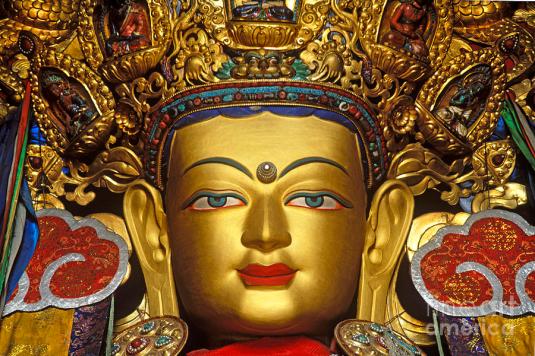
Adhokṣaja
If one were to do an image search on the Internet, of Maitreya; who is a character in the Srimad Bhagavatam, and the main person in our Previous post entitled “Vidura’s Talks with Maitreya”, the images that come up are of the Maitreya Buddha. It is interesting to note that In the Vedas, Adhokṣaja is one of the twenty-four forms of Lord Viṣṇu. Also in the Srimad Bhagavatam in the First Canto, Chapter Three, entitled “Kṛṣṇa Is the Source of All Incarnations”, Buddha is one of the incarnations to appear in this age. I thought it interesting to do a post on Adhokṣaja with some selected text from Srila Prabhupada’s books.
Maitreya Muni, who was experienced in the science of Transcendence, could understand that Vidura’s mind was fully absorbed in Transcendence. Adhokṣaja means that which transcends the limits of sense perception or sensuous experience. The Lord is transcendental to our sense experience, but He reveals Himself to the sincere devotee. Because Vidura was always absorbed in thought of the Lord, Maitreya could estimate Vidura’s transcendental value. He appreciated the valuable inquiries of Vidura and thus thanked him with great honor. (SB 3.5.18, Purport)
The Lord is explained here to be adhokṣaja, beyond the reach of all material calculation. Akṣaja means “the measurement of our senses,” and adhokṣaja means “that which is beyond the measurement of our senses.” (SB 3.19.25, Purport)
More
19 Nov 2014
by The Hare Krishna Movement
in A.C. Bhaktivedanta Swami Prabhupada, Maitreya, Srimad Bhagavatam, Vidura
Tags: A.C. Bhaktivedanta Swami Ppabhupada, all-inclusive welfare service, essence of all topics, human society, jnais, karmis, King of all kings, Krsna, Krsna-katha, Maitreya Muni, miseries of material existence, O great sage, O my Lord, saints, sri suka uvaca, Sukadeva Gosvami, Supreme King of all kings, Supreme Lord, topics of the Lord, transcendental loving service, Vidura, welfare for all people, yogis

I have been reading, with rapt attention, from Volume One, of the Third Canto, of Srimad Bhagavatam, by His Divine Grace A. C. Bhaktivedanta Swami Prabhupada, each morning. As I was reading this morning the words “…all-inclusive welfare service for the entire human society”, just kinda jumped out at me, as did the words “…greatest welfare service for the world”. I am reminded of the importance of hearing Srimad Bhagavatam every day, and of our good fortune to be able to partake in this transcendental conversation (kṛṣṇa-kathā). There are many topics for different persons in different modes of material nature, but the essential topics are those in relationship with the Supreme Lord.
Śukadeva Gosvāmī said: Vidura, the best amongst the Kuru dynasty, who was perfect in devotional service to the Lord, thus reached the source of the celestial Ganges River [Hardwar], where Maitreya, the great, fathomless learned sage of the world, was seated. Vidura, who was perfect in gentleness and satisfied in transcendence, inquired from him. (SB 3.5.1)
The great sage Maitreya Muni is described here as bhagavān because he surpassed all ordinary human beings in learning and experience. Thus his selection of the greatest welfare service for the world is considered authoritative. The all-inclusive welfare service for the entire human society is devotional service to the Lord, and, as requested by Vidura, the sage described the same very appropriately. (purport 3.5.17)
Śrīmad-Bhāgavatam: Canto 3: “The Status Quo”
By His Divine Grace A. C. Bhaktivedanta Swami Prabhupāda
Canto Three, Chapter Five, Text 1-17
Vidura’s Talks with Maitreya
More
18 Nov 2014
by The Hare Krishna Movement
in A.C. Bhaktivedanta Swami Prabhupada, Bhagavata Dharma Discourses
Tags: 1.2.6, artha, Bhagavata Dharma Discourses, bhakti, external world, New Vrindavan, pure devotional service, sa vai pumsam paro dharmaḥ, Supreme Personality of Godhead, topmost religious system

Continuning with our “Bhagavata Dharma Discourses” series given at New Vrindavan, 1972.
Śrīmad-Bhāgavatam Lecture
by His Divine Grace A. C. Bhaktivedanta Swami Prabhupada
Canto One, Chapter 2, Text 6
New Vrindaban, September 5, 1972
Pradyumna: Translation: “The supreme occupation or dharma for all humanity is that by which men can attain to loving devotional service unto the transcendent Lord. Such devotional service must be unmotivated and uninterrupted in order to completely satisfy the self.”
Prabhupāda: So
sa vai puṁsāṁ paro dharmo
yato bhaktir adhokṣaje
ahaituky apratihatā
yayātmā suprasīdati
[SB 1.2.6]
Everyone is seeking satisfaction, atyantikṣu. Everyone is struggling for existence for the ultimate happiness. But in this material world, although they are thinking by possessing material wealth they will be satisfied, but that is not the fact.
More
16 Nov 2014
by The Hare Krishna Movement
in Guru das, Photos by Gurudas, Srila Prabhupada, The Hare Krishna Movement
Tags: A.C. Bhaktivedanta Swami Prabhpada, Gurudas, morning walk with Srila Prabhupada, Photos of Srila Prabhupada, Srila Prabhupada, Srila Prabhupada at Bury Place, Srila Prabhupada in London
Photos by Gurudas
Morning Walks in London

Somehow or other, I have a large collection of Photo’s taken by Gurudas Prabhu. It is the first snowy day, and I am inside the house staying warm and looking at this large collection of photos on our computer. It would be remiss of me not to share some of these vintage photos with our readers and visitors to The Hare Krishna Movement. So this will be the beginning of our new series entitled ‘Photos by Gurudas’.
More
16 Nov 2014
by The Hare Krishna Movement
in A.C. Bhaktivedanta Swami Prabhupada, Caaitanya-caritamrta, Sri Caitanya-Caritamrta, Temples
Tags: A.C. Bhaktivedanta Swami Prabhupada, Adi lila, damsels of Vraja, Gopijana-vallabha, Govinda, grace of Krsna, Madana-mohana, neophyte devotees, reservoir of all pleasure, Sri Radha Madana Mohana, Supreme Lord, the pleasure deity

Sri Sri Radha-Madana-mohana Mandir
click on image to enlarge
As we mentioned in a previous post With the Radiance of Molten Gold “The First Chapter of Śrī Caitanya-caritāmṛta begins with fourteen Sanskrit verses that describe the Absolute Truth. Then the next three Sanskrit verses describe the principal Deities of Vṛndāvana, namely, Śrī Rādhā-Madana-mohana, Śrī Rādhā-Govindadeva and Śrī Rādhā-Gopīnāthajī.” Today we are posting the next three verses describing the principal deities, with images of the three temples. In addition we are posting verses 18 & 19. The purport to text 19, is the main content of today’s post.
…The three Deities-Madana-mohana, Govinda and Gopījana-vallabha-have very specific qualities. Worship of Madana-mohana is on the platform of reestablishing our forgotten relationship with the Personality of Godhead. In the material world we are presently in utter ignorance of our eternal relationship with the Supreme Lord… It is best for such persons not to aspire for success in fruitive activities or mental speculation, but instead simply to surrender to the Supreme Personality of Godhead. The perfection of life is simply to surrender to the Supreme. In the beginning of our spiritual life we must therefore worship Madana-mohana so that He may attract us and nullify our attachment for material sense gratification. This relationship with Madana-mohana is necessary for neophyte devotees. When one wishes to render service to the Lord with strong attachment, one then worships Govinda on the platform of transcendental service. Govinda is the reservoir of all pleasures. When by the grace of Kṛṣṇa and the devotees one reaches perfection in devotional service, he can appreciate Kṛṣṇa as Gopījana-vallabha, the pleasure Deity of the damsels of Vraja. (from purport to Adi 1.19)
More
15 Nov 2014
by The Hare Krishna Movement
in Krishna Consciousness, Letters by Srila Prabhupada, Prasadam, Vegetarian Cooking, Vegetarianism
Tags: cow protection, devotee offerings, Krsna's kitchen, meat-eating, offering of food, Prasadam, vegetarian cooking, vegetarianism

On our previous post I was searching the “Letters Books”, and just got caught up in reading…I began reading letters about offering prasadam, cooking for the Lord, and why we do not eat meat, etc. which spurred this collection of quotes on Krishna Prasadam.
Please accept my blessings. I thank you very much for your letter of May 31, 1968, which is duly in hand. I had not heard anything from you in long time, so I was very glad to hear that you are doing well. I am pleased to hear that you have so nicely installed the Jagannatha Deities at your home, and that you are worshiping Them regularly with nice offerings of prasadam, incense and flowers, and also saying prayers before Them. That is very good. Please continue chanting and reading Srimad-Bhagavatam before the Deity, and you will progress nicely. (Letter to: Krsna Devi, 13 June, 1968)
More
15 Nov 2014
by The Hare Krishna Movement
in A.C. Bhaktivedanta Swami Prabhupada, Indira devi, Letters by Srila Prabhupada, Practicing Krishna Consciousness at Home, Women, Women in ISKCON, Yogi
Tags: Bhaktivindode Thakura, ch, children of devotees, devotional service, family life, family life in Krsna consciousness, Indira devi dasi, Krishna conscious children, perfect yogi, sannyasa, Vamanadeva das, Vikuntha

My wife read me following letter this morning, that she saw on FaceBook. It is a letter written by Srila Prabhupada in 1971 to his female disciple Indira devi dasi, and is explaining how to practice household life (gṛhastha ashram) in Krishna consciousness.
My Dear Indira,
Please accept my blessings. I beg to acknowledge receipt of your letter. So far your son leaving you, his parents, at 5 years, that is not necessary. Especially our Krishna Conscious children; they are already living in a asrama. The children of our devotees may live with their parents perpetually because you are all living in the temple and already engaged in devotional service. Other instructions are for those not engaged in Krishna Consciousness. Any family engaged in Krishna’s service is living not in this material world. Such a home is considered as Vaikuntha. That is the verdict of Bhaktivinode Thakura.
Full Letter More
13 Nov 2014
by The Hare Krishna Movement
in A.C. Bhaktivedanta Swami Prabhupada, Caaitanya-caritamrta, Caitanya Mahaprabhu
Tags: A. C. Bhaktivedanta Swami Pabhupada, Adi1.4, age of kali, and the primeval Lord Himself, causeless mercy, His energies, His plenary portions, I offer my respectful obeisances unto the spiritual masters, incarnation of God, molten gold, spiritual knowledge, Sri Krsna Caitanya, srimati sacidevi, the devotees of the Lord, the Lord’s incarnations, with the radiance of molten gold

The First Chapter of Śrī Caitanya-caritāmṛta begins with fourteen Sanskrit verses that describe the Absolute Truth. Latly, I have been reading these first fourteen verses every morning, as part of my morning practice; just trying to put myself in the mood of devotional service. The following is my favorite of the fourteen and we share it with you this morning. All fourteen are posted below. Hare Krishna!
May that Lord who is known as the son of Śrīmatī Śacīdevī be transcendentally situated in the innermost chambers of your heart. Resplendent with the radiance of molten gold, He has appeared in the Age of Kali by His causeless mercy to bestow what no incarnation ever offered before: the most sublime and radiant spiritual knowledge of the mellow taste of His service.
More
12 Nov 2014
by The Hare Krishna Movement
in Cow Protection, Vegetarianism
Tags: A.C. Bhaktivedanta Swami Prabhupada, Albert Einstein, animal slaughter, cow protection, personal awareness, St. Francis of Assisi, vefetarian ethics, vegetarian diet, vegetarian lifestyle

I ran across the following article on the Sampradaya Sun the other day on Vegetarian Ethics. It is a very nice collection of quotes on the importance of a vegetarian diet, and a case against animal slaughter.
“Many people consider the ethical reasons the most important of all for becoming vegetarian. The beginning of ethical vegetarianism is the knowledge that other creatures have feelings, and that their feelings are similar to ours. This knowledge encourages one to extend personal awareness to encompass the suffering of others.” (The Hare Krishna Book of Vegetarian Cooking)
“If you have men who will exclude any of God’s creatures from the shelter of compassion and pity, you will have men who will deal likewise with their fellow men.” (St. Francis of Assisi)
More
Previous Older Entries
























